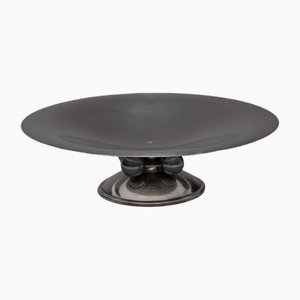French ceramist Roger Capron was born in Vincennes in 1922. He studied at Paris’s School of Applied Arts, graduating in 1943 and working for a time as an art teacher.
In 1946, Capron moved to Vallauris in the south of France and co-founded the Atelier Callis ceramics workshop along with ceramists Robert Picault (1919-2000) and Jean Derval (1925-2010). The town of Vallauris, located along the Cote d'Azur, was widely known for its pottery production dating back to Roman times. In the postwar years, the town experienced a pottery renaissance, as a number of artists—including Picasso—flocked there to work with the ancient materials and techniques.
Atelier Callis began to produce small household objects, purposefully humble and meant for everyday use. With the popularity of French ceramics at the time, however, Capron saw the opportunity to expand his output. In 1952, he parted ways with Picault and Derval and opened his own small manufactory, Atelier Capron, which employed around fifteen workers. After a few years, Capron had established an international reputation, with many of his pieces in department stores like as Saks Fifth Avenue and Gimbels. By 1980, his factory employed around 120 people and specialized in beautifully tiled coffee tables—the work for which Capron is most famous today. His success attracted imitators; in 1982, the factory shut down due to competition from makers of cheaper, mass-produced tiles.
Much like Picasso, Capron’s design aesthetic was in constant evolution, as he worked in a variety of different styles from the 1950s onwards. In his early career, Capron was a proponent of the Formes Libres movement, characterized by undulating, expressionist lines and patterns. By the 1960s, however, he had moved on to a more controlled, modernist style, with bright glazes and bold geometric patterns. Toward the 20th century, Capron’s work—which ranges from coffee tables and side tables to jugs and vases—was thought to be cliché in France and was largely forgotten. Today, however, his pieces are again highly prized by collectors around the world.
Capron won many awards over the course of his career, including gold medals at the 1954 Milan Triennale and Expo ’58 in Brussels. In 2000, the New York Times wrote that Capron was” one of the most prolific and valued artisans of postwar European design.” In 2003, the Sèvres National Ceramics Museum hosted a major retrospective of Capron’s work. He passed away in 2006.




















Get in Touch
Make An Offer
We noticed you are new to Pamono!
Please accept the Terms & Conditions and Privacy Policy
Get in Touch
Make An Offer
Almost There!
To follow your conversation on the platform, please complete the registration. To proceed with your offer on the platform, please complete the registration.Successful
Thanks for your inquiry, someone from our team will be in touch shortly
If you are a Design Professional, please apply here to get the benefits of the Pamono Trade Program